RDP 9403: Capital Constraints and Employment 3. Results
June 1994
- Download the Paper 109KB
3.1 Capacity Output
The results from stage one of the estimation procedure are presented below. Graphs 1 through 10 show the estimated capacity output frontiers for each industry division considered. It should be noted that the selection of peak levels of output is determined by the estimation procedure; they are not chosen subjectively as in other methods that connect peaks. The output data are all in constant 1989/90 dollars.




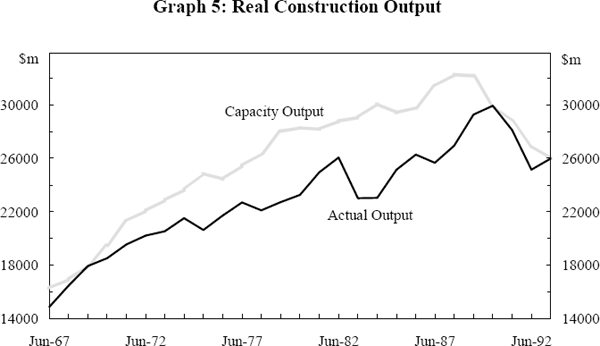



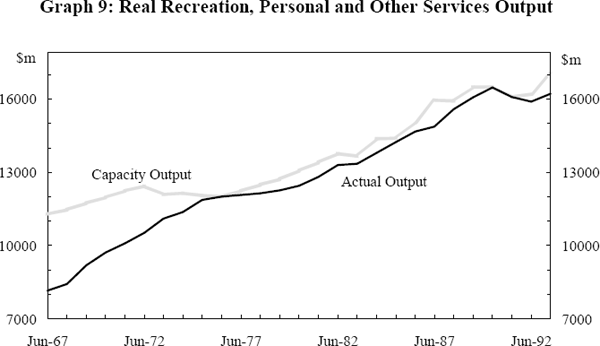
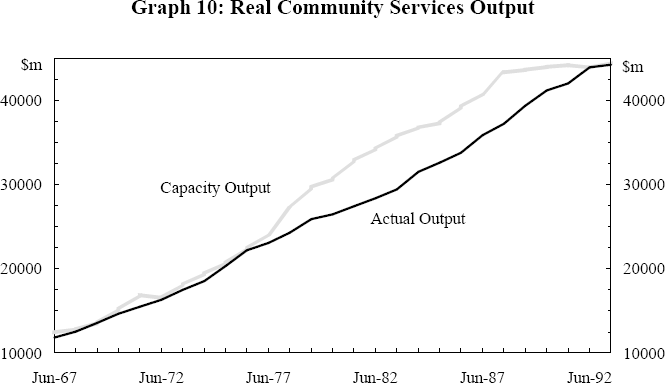
Table 1 presents the asset lives used in the calculation of the output frontiers. These lives were chosen as a general rule to be three years shorter than that used by the ABS. This is approximately the shortening that is suggested by the ABS of 5–10 per cent each decade.[21] The results generated were quite robust to variations in the asset life chosen; the results remained similar for lives of around two years either side of the ages presented. The results were also checked for sensitivity to the investment data used as these are the data that are most likely to be subject to errors. Once again the frontiers generated were very robust to relatively large variations in the investment data used.[22]
Table 2 shows the coefficients estimated in the calculation of the capacity output frontiers. Due to the presence of the constant c in the estimations these coefficients are not comparable across sectors. In general, a negative coefficient on c·a1 indicates that capital has become less productive over the estimation period.
| Sector | c·a0 | c·a1 | c·a2 |
|---|---|---|---|
| Agriculture, forestry, fishing and hunting | 17.1 | 0.12 | −1.56 |
| Mining | 36.2 | −0.08 | −2.28 |
| Manufacturing | 24.5 | −0.13 | −0.02 |
| Electricity, gas and water | 0 | 0.45 | 0 |
| Construction | 156.2 | −2.14 | −2.67 |
| Wholesale and retail trade | 90.8 | −1.37 | 0.70 |
| Transport, storage and communication | 3.7 | 0.04 | 1.31 |
| Finance, property and business services | 358.5 | −7.31 | 0 |
| Recreation, personal and other services | 143.5 | −1.85 | −4.37 |
| Community services | 506.2 | −10.33 | 39.43 |
This could reflect a trend to greater capital intensity in production and, thus, a reduction in the marginal product of capital. A positive coefficient suggests capital productivity has increased and could indicate that improvements in technology have been made. A negative coefficient on c·a2 indicates a fall in the capacity output of a particular vintage over its life and, as such, is indicative of depreciation.
The main driving force in the estimated frontiers is the investment data. The change in hours worked over the time period chosen is generally a smooth downward trend. This has the effect of pulling capacity output estimates down in later periods of the estimation. The other objective functions mentioned in footnote 6 did not greatly affect the results, as the solution which minimised equation (4) also minimised the other possible objectives.
The capacity output results on Graphs 1 through 10 suggest that the economy has excess capacity in a number of sectors. These five sectors are mining; manufacturing; transport, storage and communication; wholesale and retail trade and recreation, personal and other services. Thus, if the demand existed, these sectors could raise output with their existing capital stock. The employment implications of increasing output are considered below in Section 3.2.
Examining the results for individual sectors highlights some interesting features. The only curious result is the bulge in estimated capacity in finance, property and business services shown in Graph 8. One factor that seems to be driving this is the high level of investment through the 1980s. This would normally be expected to increase output; however, output in the finance services sector is computed by assuming constant labour productivity so changes in capital input do not necessarily affect the published output. This is in contrast to the capital-based production technology assumed in the estimation procedure. Due to the lack of correspondence between the investment and output figures the estimation procedure has difficulty fitting a tight frontier. One possible interpretation of these results is that the estimated capacity frontier more closely reflects actual output than the published figures. This is as the estimation method takes account of the effect of capital on output, which could reflect the productivity improvements in this sector from computer technology, whereas the ABS does not. However, this interpretation is limited by the fact that the estimation method is still trying to fit the data to the published output which will bias the results.
In agriculture the high output in 1979 pushes up the capacity frontier, particularly during the 1970s. Thus the low level of estimated capacity utilisation over the 1970s may be illusory. This highlights the fact that one factor not accounted for in the estimation method is the effect of weather on agricultural output. For example, drought was responsible for low output in 1983 rather than low capital utilisation. However, to maintain consistency across sectors, the same method was used for all sectors.
The pattern of growth in capacity output in the mining sector reflects the bursts in investment that have occurred in the mining sector. There are rapid rises in capacity output in the early 1970s and 1980s corresponding to investment in Bass Strait and iron ore mines followed by the resources boom. In between these periods capacity remained fairly level. Interestingly, investment has been remarkably resilient in this sector recently with capacity output estimated to be rising relatively rapidly. This may reflect the longer investment horizon of this sector which would be relatively unaffected by the recent recession.
The manufacturing sector is the only one where it is possible to compare the results with another source of data. To confirm the validity of these results we show the ACCI/Westpac survey of capacity utilisation in Graph 11 above; the peaks and troughs in capacity utilisation correspond and the magnitude of fluctuations across time are also similar. Our results identify full capacity peaks in 1982 and 1989 which accords with prior expectations. Furthermore, the results indicate that manufacturing has significant excess capacity at present stemming from previous investment decisions.
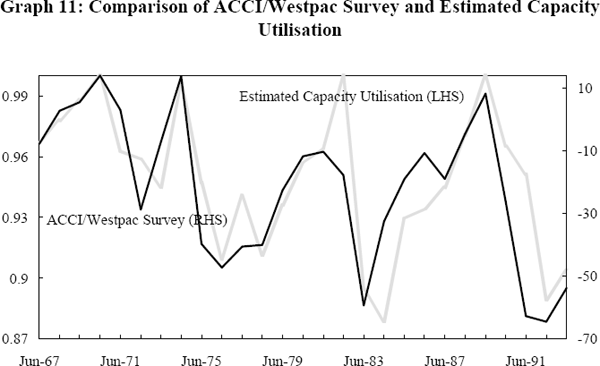
The results for the construction sector may reflect some problems with the estimation method. A few more years of data with rising output may flatten the capacity output frontier. This would make the peak in 1982 output closer to full capacity and the current capacity estimate higher. This problem is not likely to occur in other sectors as it is created by the combination of falling output and a significant drop in investment in construction. Naturally, this has implications for the estimates of capacity employment in the construction sector presented later in this paper.
In the service sectors output follows a smooth path. This stems from the labour-based method of calculating output that the ABS uses for these sectors; there are few cyclical peaks or troughs. As a result of this the estimation procedure fits a capacity frontier that is relatively close to the actual output frontier. Thus output is never estimated to be significantly below potential. This should not be a significant problem as capital is unlikely to be the primary constraint on output or employment in these sectors. Apart from the finance sector, as already noted, results for the other sectors seem fairly unexceptional. Thus, of the ten sectors, two have problems that render the results unreliable (agriculture and finance), five have excess capacity at the moment and three are capital constrained. Community services, although estimated to be capacity constrained, is unlikely to have significant problems as it has always been estimated to be close to capacity due to the non-cyclical nature of its output. Also as a service sector it is labour intensive and unlikely to be restricted by a lack of capital.
3.2 Full Capacity Employment
Graphs 12 to 21 below show results from the two stages of estimating capacity employment. The ‘productive’ employment line is the estimated level of employment once surplus labour has been removed. This is estimated as described in Section 2.2. If an abnormally high productivity result occurs which may not be directly linked to productivity improvements, as happened in 1979 for agriculture, this will displace the fitted productivity frontier further up than it should actually be, and will lead to estimated ‘productive’ employment being too low. The capacity employment line indicates the level of employment that could be sustained if the active capital stock were operated at full capacity.
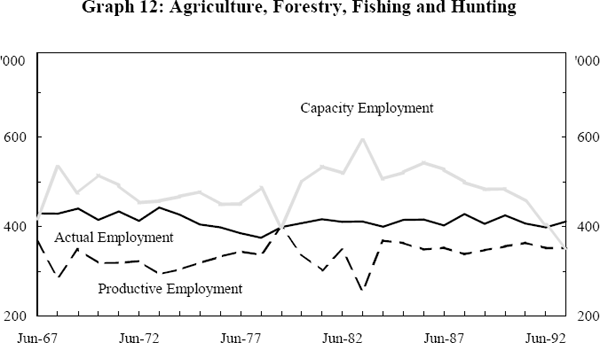







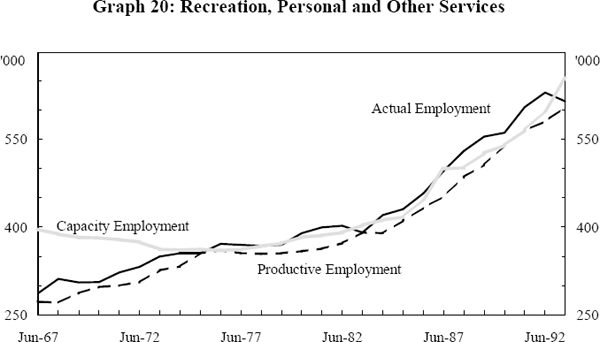
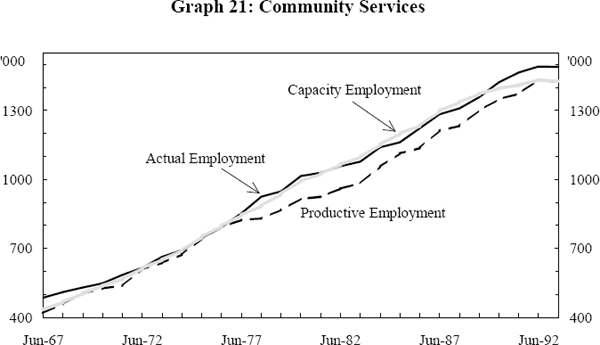
As described in detail in Section 2.2, the estimates of ‘productive’ employment and capacity employment are calculated as follows:
- Surplus labour is removed from actual employment to give ‘productive’ employment,
- an estimate of the proportion of the capital stock used to produce actual output is made for each year. The estimate of ‘productive’ employment is divided by this proportion to obtain an estimate of employment if the capital was fully utilised. Thus capacity employment always exceeds ‘productive’ employment but can be less than actual employment, particularly in years when the amount of surplus labour is high.
As the employment data include full-time and part-time employment, an underlying assumption is that the proportion of full and part time jobs is the same in new jobs created as in actual employment. Another assumption is that surplus labour is equally spread between full and part-time employees. If we assumed that surplus labour was concentrated among full-time employees this would raise the employment identified as ‘productive’ employment (as a larger number of ‘non-productive’ hours would be absorbed by a given number of employees). It is possible to present these results in terms of total hours worked – the shape of the graphs will remain the same, only the scale would change. This would remove any need to make assumptions about the proportion of full and part-time jobs created; however, some assumption about full and part-time work would then be needed to derive any implications for employment.[23] Given this it seems more useful to assume that the proportion of full and part-time employment is the same on the extra jobs.
In aggregate there would seem to be limited scope for new employment as there is underemployment or labour hoarding still occurring in some sectors which offsets the potential for growth in other sectors. Employment possibilities are distributed unevenly between sectors; some sectors could increase employment whereas others are estimated to have surplus labour. More interesting points can be gleaned from a consideration of the individual sectors.
The results for agriculture are affected by the 1979 output observation. This peak affects both the levels of labour hoarding estimated on either side of the peak and the large increase in employment due to low capacity utilisation on either side of the peak. As such it is difficult to make any definite statements about this sector.
The electricity, gas and water sector has reduced much of the surplus labour evident through the 1980s to the point where there is relatively little currently employed. The high level of estimated surplus over this period may be related to high levels of investment over this period. Labour employed in investment activities would be ‘non-productive’ in that no output could be directly attributed to it. The overall impression is that the industry has reduced employment to a more efficient level than previously where most employees are productively employed, operating the capital close to capacity.[24]
In construction, except for the dip in 1983, there seems to have been a consistently high level of surplus labour. This could be distorted due to the unusually productive 1983 result; however, this is less likely than for the agriculture sector where climatic conditions affect the results substantially. Interestingly, employment in construction has been rising even though output and estimated capacity have fallen. This is in contrast to the trend evidenced in other sectors where job losses have not been reversed.
The estimates of surplus labour in the finance, property and business services sector are relatively small. This is to be expected given that the ABS estimates output in this sector by assuming a constant level of labour productivity. However, as the ABS uses different data and somewhat complicated methods the level of productivity calculated in this paper is not perfectly flat over time and hence there is some estimated surplus. The large bump in capacity employment is an artefact of the high capacity output estimated in the first stage. Results for the other sectors seem unremarkable.
3.3 Investment Projections
Projections of investment required to sustain various rates of employment growth are presented below in graphs 22 to 31.[25] The employment growth rates considered are 1.4 per cent, 2.2 per cent and 3.1 per cent. These projections are dependent upon the assumption made about the path of the capital to labour ratio. The assumptions made in this paper, as discussed in Section 2.3, are most likely to be an overstatement of the path this ratio will follow. As such, these projections will probably be higher than actual requirements.


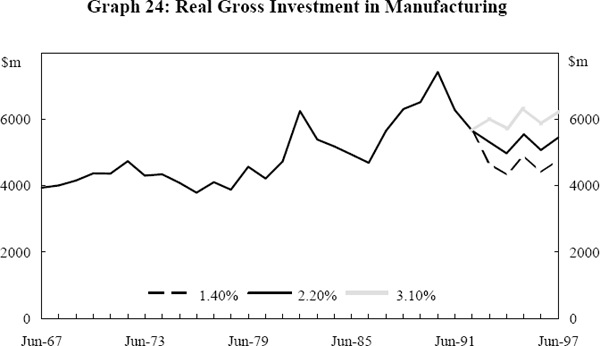



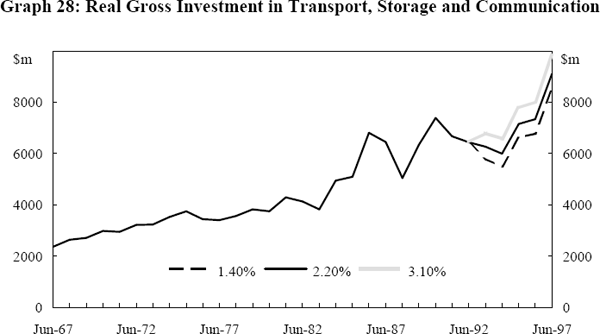
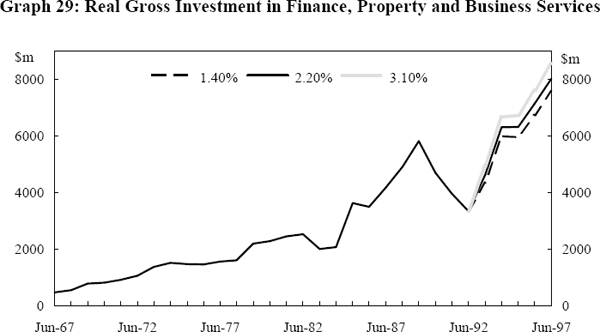


In the graphs below investment data since 1967 are included with the projections to provide some idea of whether the projections are consistent with the historical pattern of investment in each sector. The data used are public and private gross fixed capital expenditure in plant and equipment by sector in constant 1989/90 prices. The different lines indicate the investment paths required for employment growth at the levels indicated in the legends.
It appears that the investment rates required to generate employment are not excessive. In most cases an initial jump in investment is projected followed by modest growth; this jump can be substantial. However, these projections assume that employment growth resumes immediately. If employment growth was projected to resume gradually the investment requirement could be spread over more years. Thus, instead of an excessive jump in the first year being necessary, sustained investment over a longer period would suffice. The highest requirement for growth is in finance, property and business services where a return to the boom levels of the 1980s is required. This projection could be affected by the high trend in the capital to labour ratio through that period. Projecting the capital to labour ratio to grow at the rate of the 1980s, as is done in this method, may be an unreasonable assumption which biases the projections upward.
If the results are aggregated across sectors they suggest that an initial jump in investment of 27 per cent is consistent with employment growth of 2.2 per cent. Thereafter, growth rates of around 5 per cent are sufficient to maintain the employment growth. However, the initial jump is distorted by the results for the electricity, gas and water and construction sectors where investment has fallen significantly over the past few years. If these sectors are excluded the initial jump required in investment is 19 per cent. Thus, while the initial jump in investment is substantial the rates following are not abnormal; for example, from 1984 to 1985 private investment grew by 16 per cent.
At a sectoral level it is interesting to note that the requirements in the manufacturing sector do not involve an initial jump. Investment in this sector in the past three years has been relatively high. While it has fallen from a peak in 1989 it seems to be a return to a longer run trend. In comparison, investment in the electricity, gas and water sector has to jump quite a long way, as investment has fallen to practically nothing over the past few years. However, the required level of investment is not unreasonable given the historical pattern of investment in this sector.
Footnotes
Asset life in the finance services sector was shortened somewhat more than this due to the impact we assumed that computers have had on asset lives. [21]
To check the results the investment data was changed by a random amount in each period with a standard deviation of 5 per cent. The frontiers generated from a large number of repetitions of this process were then graphed to identify ‘error bounds’. In all cases the general shape of the frontiers remained the same, although the levels moved around somewhat. Importantly, the peaks selected as being full capacity remained the same for all trials. [22]
The estimation that 40,000 more hours are worked could involve 1,000 more full time jobs or 2,000 more part time jobs. Some assumption would need to be made about this proportion to identify the exact level. [23]
It is, however, possible that some excess capacity still exists in this sector as the estimation merely indicates that this sector is closer to capacity than it has been over the estimation period. [24]
Once again, we stress that these projections are not forecasts. They are model-generated, hypothetical scenarios. [25]